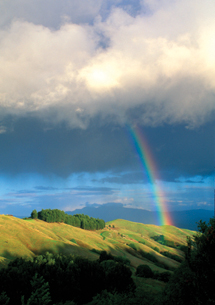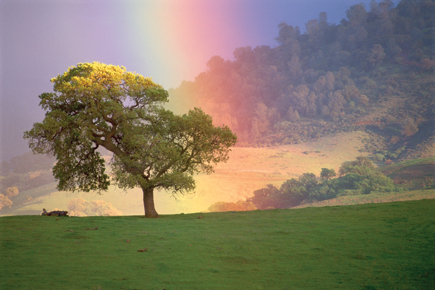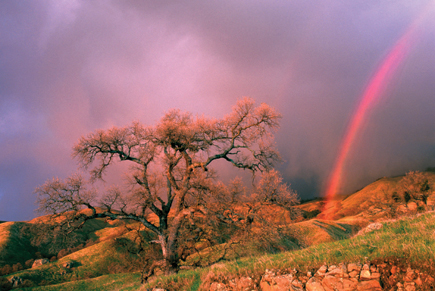Over The Rainbow; Tips For Catching That Magical Light
Rainbows have inspired legends of luck and good fortune. The beautiful colors are created in a simple process. Capturing a rainbow with your camera takes a bit of that good luck.
 |
|
|
Rainbows require two simple ingredients--sunlight and raindrops. They combine at just the right angle to colonize a beautiful picture. The colors are formed when raindrops separate white sunlight into the component colors of the rainbow. Water drops act like little prisms. This light-bending process is called refraction. The separate colors are then reflected off the raindrops; each drop of water reflects a single color that changes with your angle of view. This is why the colors appear in stripes.
 |
|
|
Determining when to get out in the rain will increase your luck of being in the right place at the right time. Rainbows only appear during the early morning and late afternoon. Rainbows are reflected below the horizon once the sun rises above 30°. I have had my best luck chasing rainbows during the last three hours of the day.
 |
|
|
Heavy rain and bright sunlight create rainbows with the most vivid colors. The edge of a storm is a perfect time to find bright sunlight reflecting rainbows off pouring rain. I use the satellite and radar imagery from the National Weather Service at www.noaa.gov. I look for storms with bands of rain clouds mixed with clear skies. These storms hold the most promise for producing intense rainbows. The animated radar loop can show you the direction and speed these storms are traveling. Weathermen forecast good rainbow days as isolated rain showers mixed with periods of sun.
 |
|
|
Once you find a rainbow you need to capture it with your camera. I still use
my good old Minolta Maxxum 9xi film body when I shoot scenic landscapes. Rainbows
just look better to me with the added saturation of Fujifilm's Velvia
slide film. I always use my Bogen tripod outdoors to precisely line up my shots.
I want to be able to set it and forget it as I bracket my exposure.
I use a polarizer in the "off" position to further saturate and
intensify the colors. A rainbow is a reflection and a polarizer will make the
rainbow completely disappear in the "on" position. Spin it 90°
to turn "off" that effect.
 |
|
|
Most rainbows are set against dark storm clouds. The lighting is pretty evenly balanced. I choose not to take the extra time to spot meter the scene when shooting rainbows. I choose instead to bracket my exposure two full stops over and under what the center-weighted, matrix metering system is reading for the overall picture. I want to make sure I have just the right frame to choose from the bracket. Getting the rainbow is more important than extra film or a few additional megabytes of storage space. Mix up your cropping between horizontal and vertical views. Just keep shooting until the rainbow fades into sky.
 |
|
|
My "Over the Rainbow" shot was taken with a Sigma 400mm APO 5.6 lens and polarizer on Velvia slide film. It had been raining hard all afternoon when I ventured out. There was a small stream advisory and tornado watch in affect. I arrived at my favorite oak tree just as the sun appeared in clear sky. All the ingredients for a vivid rainbow were playing their part. I could see both ends of the rainbow. I took 50 pictures before it was done. The cows below the oak tree never stopped grazing to appreciate the colors. I knew I had seen something magic. It gave new meaning to Ansel Adams' quote: "Sometimes I arrive just when God's ready to have someone click the shutter."
 |
|
|
Successfully chasing rainbows requires good timing, patience, and a bit of good luck. You need to be willing to get out in the rain to find your rainbows. Use the high-tech tools provided by the National Weather Service to help you be in the right place at the right time. Maybe you, too, can find a pot of gold at the end of your rainbow.
To see more pictures by Brad Perks, visit his website at http://pcimagenetwork.com.
- Log in or register to post comments

















































